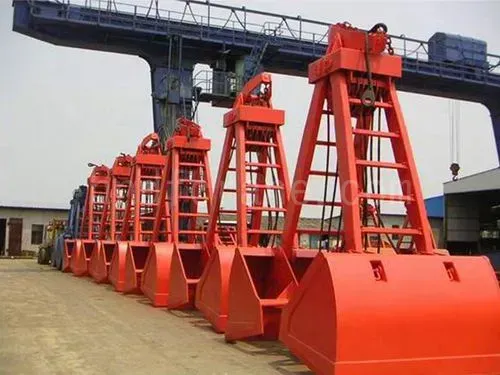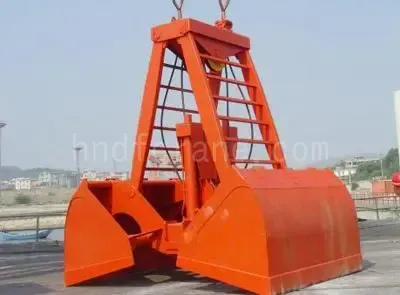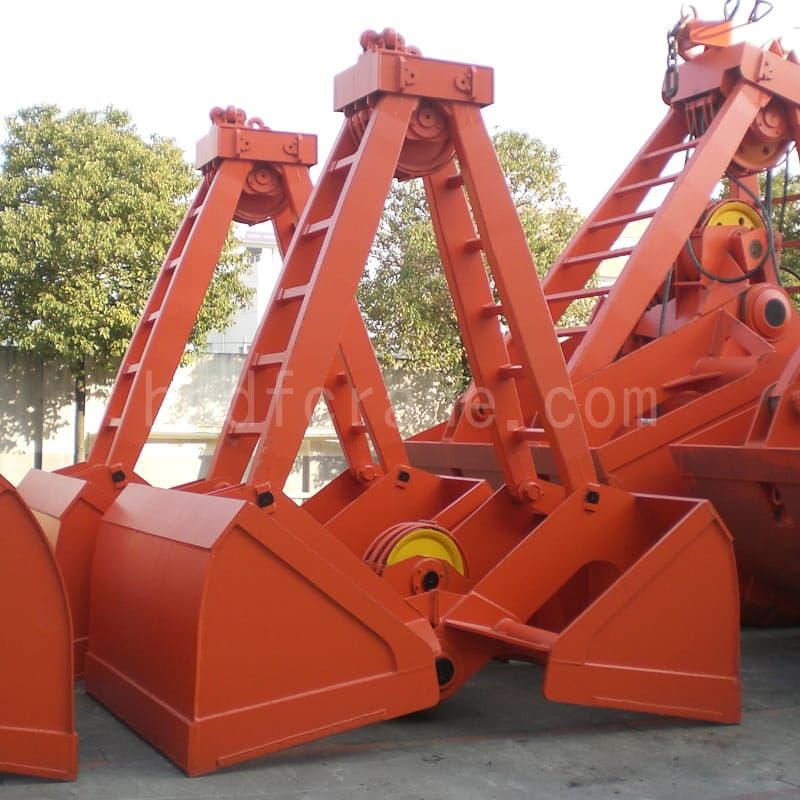Produkteinführung der mechanischen Zweiseilgreifer
Der mechanische Zweiseil-Zweischalengreifer ist für alle Arten von Kränen mit Doppelhebevorrichtungsstruktur geeignet und wird hauptsächlich in Häfen, Docks, im Straßen- und Brückenbau und in anderen Industriezweigen eingesetzt.
Je nach Materialeigenschaften kann er in den Ausführungen leicht, mittel, schwer und superschwer ausgestattet werden. Geeignet zum Aufnehmen von losen Ansammlungen aller Art.
Dann verschiedene Kräne. Ausgestattet mit zwei Sätzen Motorrollen (d. h. elektrischen Hebezeugen), führt jeder Rollensatz zu einem Drahtseil, von denen eines als Stütze für den Greiferausgleichsrahmen dient, und das andere Drahtseil verläuft durch die Riemenscheiben der oberen und unteren Balken, um einen Flaschenzugblock zu bilden, der beim Öffnen eine Rolle spielt.
Mechanische Zweiseil-Zweischalengreifer sind ein effektives Werkzeug zum Be- und Entladen von Schüttgütern wie gelbem Sand, Kohle, Erzpulver und Schüttdünger in verschiedenen rauen Umgebungen.
Mechanische Zweiseil-Zweischalengreifer haben eine einfache Struktur, einen neuartigen Öffnungs- und Schließmechanismus, sind leicht zu bedienen und können die Öffnungs- und Schließvorgänge in verschiedenen Zuständen präzise ausführen.
Mechanische Zweiseilgreifer verwenden ein dreidimensionales virtuelles Design und die ANSYS-Software wird zur Festigkeitsanalyse und -überprüfung verwendet. Die Gewichtsverteilung ist vernünftiger und die Lebensdauer länger.
Der obere Tragbalken der mechanischen Zweiseil-Zweischalengreifer ist mit Ösen ausgestattet, die direkt mit der Hebeseilschäkel des Krans verbunden werden können.
Technische Parameter der mechanischen Zweiseilgreifer

| Typ und Größe | Volumen(M3) | Eigengewicht (t) | Abmessungen (mm) | Scheibendurchmesser.(mm) | Höhe verwenden(M) | Stahlseildurchmesser.(mm) | Traglast(T) | ||||
| A | B | C | D | E | |||||||
| BS3[1.2]1.3A | 1.2(300) | 1.4(4) | 1900 | 2537 | 2488 | 2841 | 1200 | ø400 | 9 | ø17,5 | 3 |
| BS3[1.6]1.4A | 1.6(300) | 1.4(4) | 2100 | 2631 | 2559 | 3040 | 1300 | ø400 | 9.5 | ø17,5 | 3 |
| BS5[1.5]2A | 1.5(350) | 2(3) | 2000 | 2659 | 2667 | 3075 | 1260 | ø445 | 8.5 | ø19,5 | 5 |
| 2(4) | 9.8 | ||||||||||
| BS5[2]2A | 2(350) | 2(4) | 2100 | 2778 | 2818 | 3248 | 1400 | ø445 | 10 | ø19,5 | 5 |
| BS5[2.5]2A | 2.5(350) | 2(3) | 2100 | 2787 | 2715 | 3091 | 1600 | ø445 | 8.5 | ø19,5 | 5 |
| BS5[3]2A | 3(400) | 2(3) | 2300 | 3130 | 2938 | 3362 | 1650 | ø445 | 9 | ø19,5 | 5 |
| BS8[2.6]3.2A | 2.6(300) | 2.6(4) | 2300 | 3038 | 3257 | 3736 | 1800 | ø560 | 11 | ø26 | 8 |
| BS8[3]3.3A | 3(300) | 3.3(4) | 2380 | 3118 | 3287 | 3786 | 1900 | ø560 | 11.5 | ø26 | 8 |
| BS8[3.8]3.5A | 3.8(300) | 3.5(4) | 2550 | 3536 | 3286 | 3733 | 2000 | ø560 | 12 | ø26 | 8 |
| BS8[4.5]3.8A | 4.5(300) | 3.8(3) | 2500 | 3505 | 3503 | 3975 | 2300 | ø560 | 12 | ø26 | 8 |
| BS10[3]4A | 3(300) | 4(4) | 2380 | 3118 | 3287 | 3786 | 1900 | ø560 | 11.5 | ø28 | 10 |
| BS10[5]4A | 5(350) | 4(4) | 2615 | 3605 | 3503 | 3975 | 2400 | ø560 | 12 | ø28 | 10 |
| BS10[6]4A | 6(400) | 4(4) | 2800 | 3814 | 3758 | 4290 | 2150 | ø560 | 12.5 | ø28 | 10 |
| BS16[3.6]6A | 3.6(300) | 6(5) | 2500 | 3313 | 3810 | 4206 | 2100 | ø720 | 13.5 | ø32 | 16 |
| BS16[4]6A | 4(350) | 6(5) | 2500 | 3313 | 3810 | 4206 | 2200 | ø720 | 13.5 | ø32 | 16 |
| BS16[6]6A | 6(350) | 6(4) | 2900 | 3800 | 4249 | 4612 | 2400 | ø720 | 13.5 | ø32 | 16 |
| BS16[10]6A | 10(400) | 6 (3) | 3200 | 4000 | 3938 | 4673 | 2500 | ø650 | 12 | ø28 | 16 |
So wählen Sie den richtigen Greifer
- Klären Sie Ihren Zweck:
Bevor Sie sich mit den Optionen befassen, klären Sie bitte Ihre spezifischen Anforderungen. Fragen Sie sich selbst:
- Mit welchen Materialien möchten Sie sich befassen? (Baumstämme, Metallschrott, Steine usw.)
- Welche Aufgaben soll der Greifer erfüllen? (Beladen, Sortieren, Zerlegen etc.)
- An welchen Gerätetyp wird es angeschlossen? (Portalkran, Brückenkran)
- Wie hoch ist das spezifische Gewicht des Materials, das Sie greifen? Wie viele Würfel hat der Greifer?
Welche Tonnage hat Ihr mit Greifer ausgestatteter Kran?
Je nach den Eigenschaften des zu greifenden Materials wird der Greifer üblicherweise in vier Grundtypen unterteilt: leicht, mittel, schwer und superschwer.
| Die Art des zu greifenden Materials | Greifermaterial | Kapazitätsgewicht (t/m³) |
| Licht | Koks, Schlacke, Getreide, Kartoffeln, Anthrazitkalk mittlerer Qualität, Zement, Erde, Kies, Ton, Ziegelbruch usw. | 0.5~1.2 |
| Medium | Torf, große Stücke Anthrazitkohle, verdichtete Kohle, Ton, Kalkstein, Kies, Salz, Schotter, Ziegel, Bauxit, Eisenoxidflocken, Zement, Sand und Ziegel in Wasser usw. | 1.2~2.0 |
| Schwer | Kalkstein, schwerer Ton, kleine und mittelgroße Erze, Hartgestein, stäbchenförmiges Eisenoxid, Eisenerz, Bleikonzentratpulver usw. | 2.0~2.6 |
| Übergewicht | Große Erze, großes Manganerz, sedimentär agglomeriertes Bleierzpulver usw. | 2.6~3.3 |
- Zubehörkompatibilität: Stellen Sie sicher, dass der Greifer mit der vorhandenen Ausrüstung kompatibel ist.
- Budgetüberlegungen: Die Preisspanne des Greifers ist unterschiedlich. Bestimmen Sie Ihr Budget anhand der Funktion und Haltbarkeit des Greifers.
- Kommentare und Vorschläge: Recherchieren Sie online, lesen Sie Benutzerberichte und holen Sie sich Vorschläge von Branchenkollegen.
- Gehen Sie vor dem Kauf zum Kranhersteller zur Inspektion und Prüfung vor Ort: Testen Sie den Greifer so oft wie möglich unter realen Bedingungen. Bewerten Sie seine Leistung, Benutzerfreundlichkeit und Gesamtfunktionalität.
Denken Sie daran, dass die Wahl des richtigen Greifers ein Gleichgewicht zwischen Funktionalität, Sicherheit und Kosten erfordert. Durch die Berücksichtigung dieser Faktoren























































































